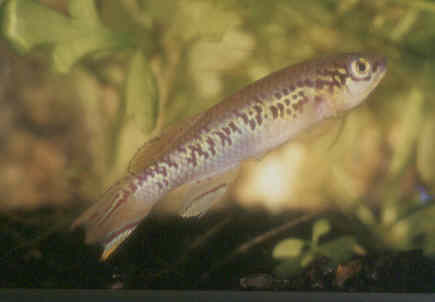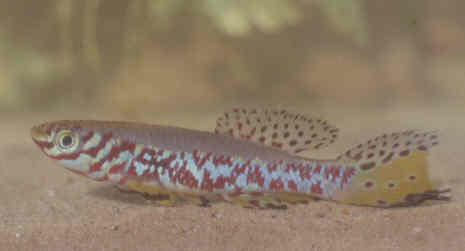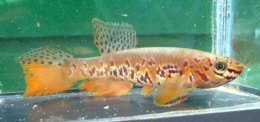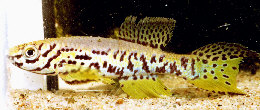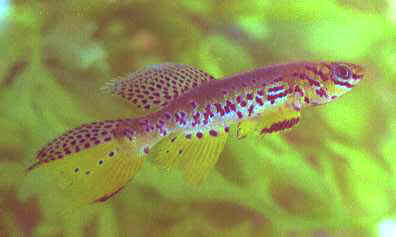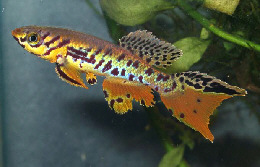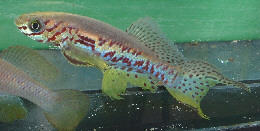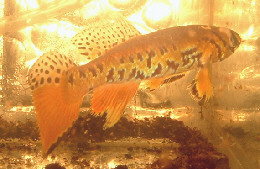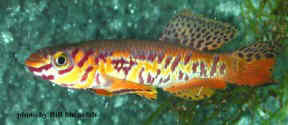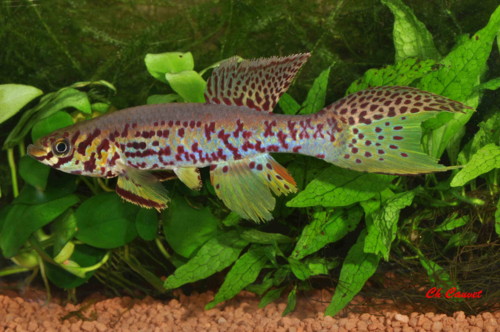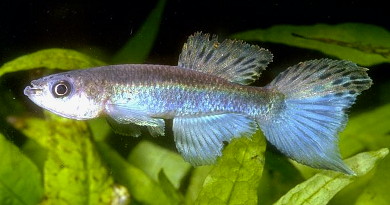Fundulopanchax fallax (Ahl 1935)
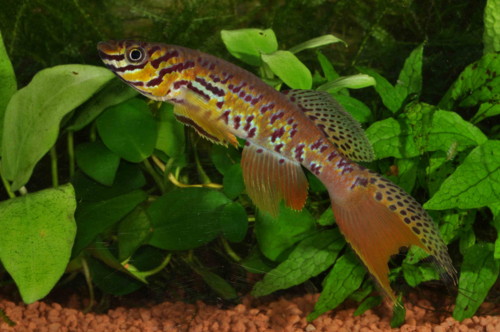
Fifinda - ADK 09 / 301
Photo courtesy of Christian Cauvet
| Meaning of Name |
After the latin - fallax, meaning deceptive. This refers to the resemblance with Fp.gularis. |
||||||||||||||||||||||
| First Description |
Ahl E. 1935. Aphyosemion (Fundulopanchax) fallax. Beschreibung zweier neuer Süsswasserfische aus West Afrika. Zoologischer Anzeiger 110 (9-10): p 251-253. |
||||||||||||||||||||||
| Size |
13 cm |
||||||||||||||||||||||
| Meristics |
|
||||||||||||||||||||||
| Karyotype |
n = 18, A = 29 (Scheel 1990) |
||||||||||||||||||||||
| Sub-Genus |
Gularopanchax |
||||||||||||||||||||||
| Group |
|
||||||||||||||||||||||
| Synonyms |
|
||||||||||||||||||||||
|
Populations
|
Fifinda - Personally I
consider Fifinda, CI 98 & CI 99 to be the same collection. All
commercially collected & shipped out. Obviously their is going
to be a variance in colouration & pattern. We know an orange &
a yellow variant exists. Commercial collectors have said they caught
both in the same pool of water.
ADK 09 / 301 Fifinda
- I believe some 150 fish were taken back to France from the
collection & these were orange & yellow forms. Collection
site 5km west of Fifinda. Circulated in France 2010. This collection
(from photos seen) has an anal diagonally split with upper orange
& green lower in some specimens whilst others are fairly clear.
Other photos show this orange to a much lesser degree. Body patterns
follow the Fifinda imports into the UK from commercial sources.
Mouanko
- This population was well known in Fp.
circles. Photos exist of a blue form taken in France. This is a slate
grey/blue looking fish. It's not that colourful so probably will not
stand the test of time in hobbyists tanks. This one should be called
Mouanko Blue.
|
||||||||||||||||||||||
| Type Locality |
Given as the Gold Coast, now Ghana. Types were used from aquarium material where the exact collecting location was unknown. Ahl quotes the Gold Coast as the type locality but this is considered to be an error as the Niger Delta is the probable correct location. See also Fp.deltaensis |
||||||||||||||||||||||
| Distribution |
Coastal western Cameroon from Malende in the north to Kribi in the south. |
||||||||||||||||||||||
| Habitat |
Swamps & swampy areas of brooks in humid rainforest. Collected by A.C.Radda in December 1974. He reported - "in water holes of a swampy spring area of a brook about 3 km upstream. The brook crosses the Kribi-Campo road about 7 km south of Kribi near the ferry across the Lobé River, East Cameroon. After an exhausting upstream march of one hour across fallen trees, I was lucky enough to catch one female and three males... I suddenly realized that I had lost my bearings. Again after climbing over cross-lying trees and penetrating very dense vegetation, being bitten by ants and stung by many mosquitoes and flies, I found my way back and arrived completely wet... from my involuntary bath in a deep pool... On seeing my car again, I felt quite relieved." |
||||||||||||||||||||||
| Distinguishing Characteristics | Heavily spotted fish on flanks & dorsal & anal fins. Spots of dark red to purple. Caudal fin is distincly split with the upper third heavily spotted. | ||||||||||||||||||||||
| Colour/Pattern Variability | Fairly high. Blue morphs are known in the wild & have been collected at Fifinda & Mouanko. | ||||||||||||||||||||||
| History |
First documented reports of this sp. were given by Schreitmüller in 1933 where he mentions being informed of a 'yellow Fundulus' arriving from the Gold Coast. He had some pairs from Härtel of Dresden. They considered them sufficiently different from the then gularis & sent some preserved specimens to Norman at the British Museum who identified this material as spurelli (Fp.walkeri). This species had not been imported as an aquarium fish at this time. Arnold, in 1934 had 2 preserved specimens from this importation supplied by O.Scholze of Berlin who considered them to represent Nothobranchius gularis. Arnold considered they were closest to batesii. He compared them with Schreitmüller's notes & figure & found them to be comparable. These were sent to Norman at the British Museum & were identified as gularis. In 1935 Schreitmüller realised Norman's identifications were not in agreement & he asked him for an opinion to which he replied that Arnold's fish originated from the Niger Delta. Schreitmuller sent two preserved specimens to Ahl in Berlin who considered them to represent a new species & named them Aphyosemion (Fundulopanchax) fallax. Sterba considered this sp. to come from Ghana in his work Freshwater Fishes of the World. I was talking to Alan Green who remembers getting fish with no colour in wild imports in the '90's so the blue form has been in the UK - it's just not been bred here.It seems to be a commonly recurring thread in collections commercial & private of these blue/colourless forms. History of the synonym Aphyosemion schwoiseri Scheel & Radda 1974. Initially described as a subspecies
of A.gulare in 1974. Radda raised
it to species level in 1975. History of the synonym Aphyosemion kribianum Radda 1975. Collected in the early part of 1973
by a large group of German aquarists collecting in the Kribi area. They
collected only one male of this sp. The biotope was a rainforest brook
close to the ferry crossing on the Lobe River. This male died in transit. |
||||||||||||||||||||||
| Breeding Notes |
Males can be aggressive & a larger aquarium is recommended for spawning with plenty of cover for female/s in the form of mops &/or plants. Salt should be added at the rate of 2-3 teaspoons per gallon. The water should also be acid (pH 4·5 - 6·0 maximum). The bottom can be covered in silver sand or peat depending on how you prefer to collect eggs. I found the best way was to remove the fish every 2 weeks & stir the sand up. On settling swish a net in a figure '8' pattern through the water to collect the eggs. Repeat this 3 times to collect the majority of the eggs. These eggs should be placed in clean rainwater & left for 7-10 days discarding any fungussed eggs. The colouration of the egg will turn a murky white & many an egg has been discarded at this stage thinking they had gone bad. A great way of detecting bad eggs is to use 'chelated iron' this also makes the water more acid & removes phosphates. Place these eggs onto damp peat/coconut fibre or place in this medium in a bag & leave to incubate which takes 5-8 weeks. Some eggs will resist this initial hatching & the peat should be re-dried for a couple of weeks before wetting again. Fry can take newly hatched brine shrimp as a first food. Growth is rapid with sexing out starting after about 4-5 weeks. Larger fish should be moved on to another tank as they can eat smaller fry. When first imported to the UK (early '70's) it
was thought the eggs needed 8 weeks dry storage. Later it was found
that 5-7 weeks was a better incubation period. Water incubated eggs kept slightly warmer (around
80'F) with a very slight aeration in the container take 7 weeks to hatch. In e-mail correspondance with a BKA member who
had the Fifinda Orange form he informed me that the parents ignored
mops, fibre & peat to spawn in but favoured the roots of the plant
Java Fern. Hundreds of eggs were found here. Paul Carter in BKA newsletter No.536, May/June 2010 gives a breeding account - Fish were set up to breed at 4 months of age. Males were 4" excluding tail. Two large containers of peat were added, one at each end of the tank. No eggs were found in this peat (probably due to low temperatures of 18-20°C) until the peat was taken out when the fish were 9+ months old. The fish were kept in a fish house with a clear roof. As it was going into summer the older fish were in warmer water & this is thought to be the reason for a greater number of eggs. A lot of eggs present which were eventually hatched at 8-10 weeks incubation |
||||||||||||||||||||||
| Diameter of Egg | Quite large. | ||||||||||||||||||||||
| Remarks |
I have found that large, older males of the Fifinda
population are vulnerable to shock very easily. This is not as a result
of old water I have observed. They will play dead by curling up on the
tank base & to all intense & purposes stop breathing with no
movement noticeable on the gill plates. The Fifinda varieties were widely distributed in an effort to conserve them in the hobby. In 2002 both yellow & orange were still being maintained in the USA. My personal opinion is that if a line is bred long enough a few blue/colourless forms will crop up. This shows through in collections from various collection locations. A gene 'crack' is perhaps a common thing with this sp. References - KCF Newsletter No.3/2010, May/June. |
||||||||||||||||||||||
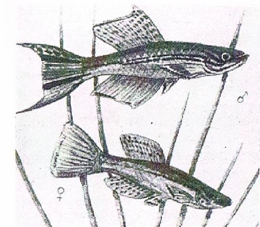
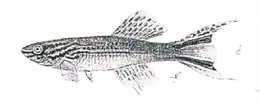

_Kribi_Purzl.jpg)
